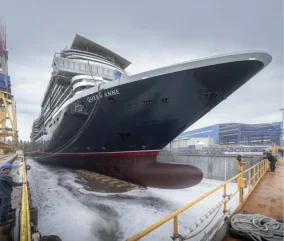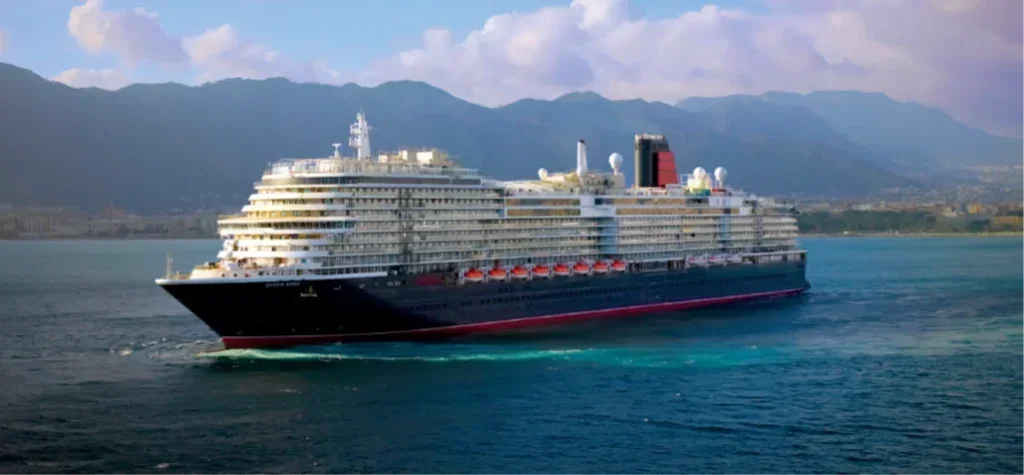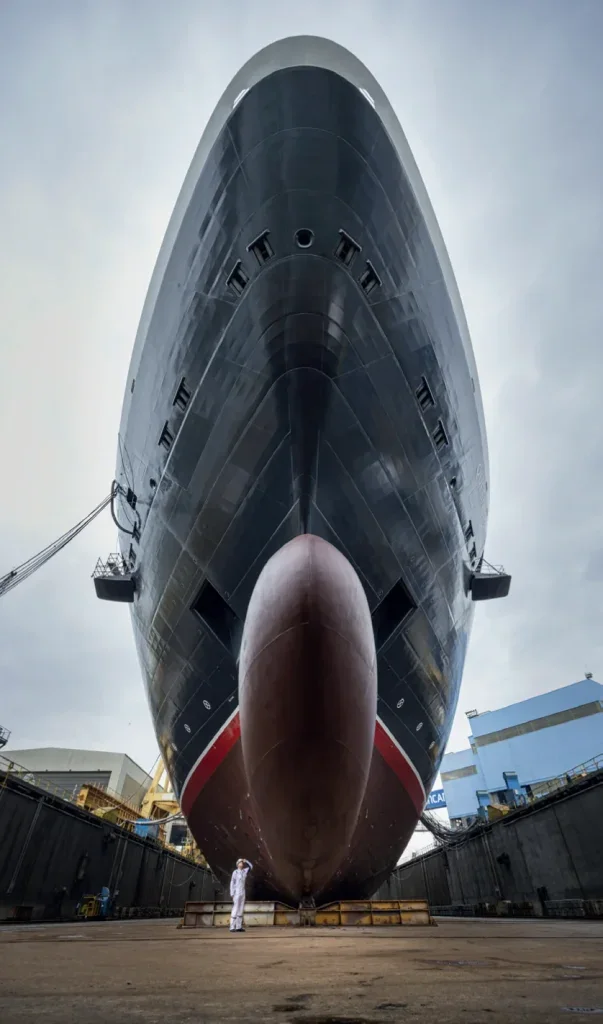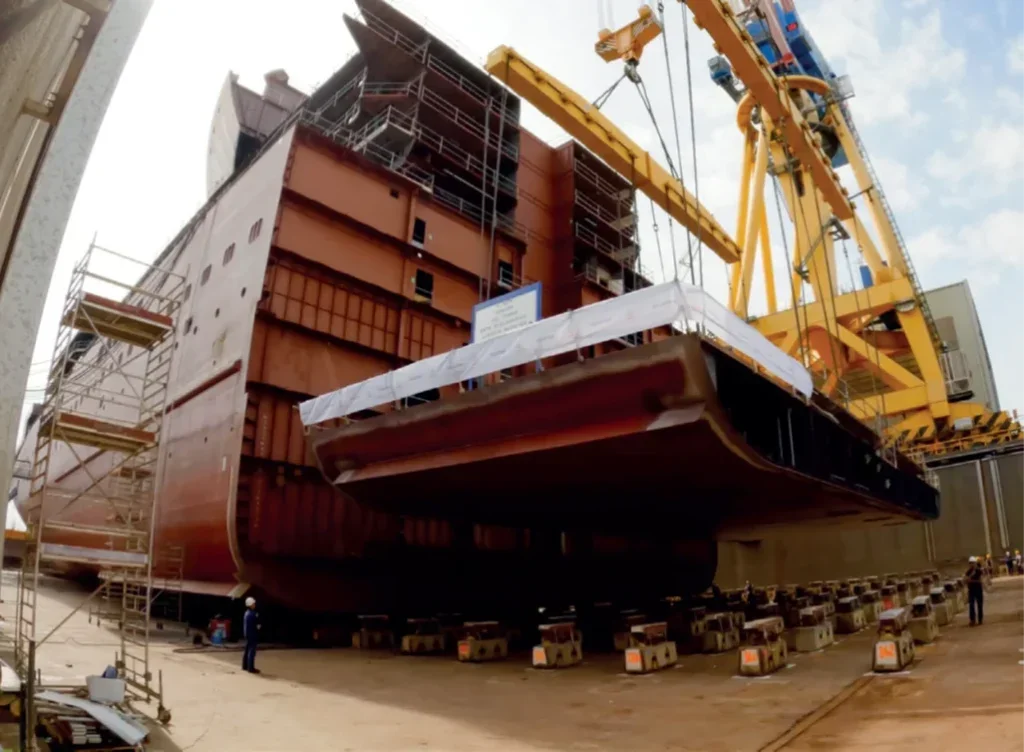
Cunard doesn’t launch new ships very often. The last vessel to debut was Queen Elizabeth in 2010. So, by the time Queen Anne’s launch date finally rolled around in May 2024, expectations were through the (glass-domed, retractable) roof. As the longest-operating shipping company in the world – Cunard traces its origins back to 1840 – the pressure was on to both honour the brand’s 184-year-old heritage and bring it firmly into the 2020s.
From an amenities perspective, the British-born cruise line has hit the mark. Queen Anne both tells the story of Cunard’s history and turns the page on a new chapter for the brand. While its signature venues – from the Golden Lion Pub to the Britannia Restaurant – are all intact, Queen Anne guests can also access more dining outlets than ever before (the ship offers 15) and the widest selection of fitness, beauty, thermal and spa facilities so far seen on a Cunard ship.

As well as a brand-new, top-deck wellness studio, Queen Anne also features a multi-purpose pavilion – a versatile space featuring a swimming pool as well as a central stage and large LED screen for open-air theatre, cinema screenings and live music.
It’s the culmination of five years of work by a collective of world-leading designers, including David Collins Studio, Richmond International and Paris-based Sybille de Margerie, and the shipbuilders at Fincantieri, all of whom were tasked to help Cunard take the luxury travel experience further, drawing on inspiration from the past to set the brand up for the future.
A ship for the future: going back before we go forward
Weighing in at 113,000t, Queen Anne accommodates 3,000 passengers and 1,225 crew members over 14 decks. The ship, which was constructed in phases, with the bow and forward hull being built and launched separately to the stern, can achieve a cruising speed of 40.7km/h (22kt). Its hull and technical characteristics are based on the Pinnacle series 4 class of Holland America Line, with an increased length of 22m and an increased beam of 0.6m, as well as other customisations.
Fincantieri Queen Anne project manager Guido Cucciniello explained in April: “The architectural concept and the accommodation are completely redesigned according to Cunard’s bespoke design. Queen Anne will be significantly bigger than the previous Cunard ships built by Fincantieri (Queen Elizabeth and Queen Victoria) with 114,000gt instead of 90,000gt.”
One of the most striking spaces on Queen Anne is the Grand Lobby, which was designed by the team at David Collins Design, and, due to lighting effects that range from bright to ‘glamorous’, changes ambience throughout the day. Looking at the finished product, with its three-storey-high brass fin mural that rises from deck one up to the top of deck three, and is back-lit to depict the form of the ship, you wouldn’t guess it was their first experience of working in the maritime sector.
But as David Collins Studio’s design director, Lewis Taylor, explained, “Queen Anne doesn’t really compare with anything else we’ve ever designed here at David Collins Studio. The challenge was designing all of that in one place in basically a hotel that moves.”
With all their projects, the studio goes back before they go forward. And Queen Anne was no exception. “We immediately went to Liverpool to visit the archive and see all these amazing references, whether it be art deco furniture designs, to tapestries or wood timber veneers,” recalls associate designer Jason Stewart. “A lot of brands try to borrow that heritage, but Cunard really invented the golden age of travel.”
113,000t
The weight of Queen Anne.
Another of the ship’s most impressive design elements is the specially designed glass dome roof of the pavilion, which retracts in warmer weather. Acclaimed architect Martin Francis – who supported with engineering the iconic Louvre Pyramid in Paris – led a redesign of the glass dome, which now features a refined arched steel frame to maximise height and light in the space as it stretches up and aft to create the new Wellness Studio, which was also designed by David Collins Studio.
3,000
The number of passengers Queen Anne accommodates.
“We took those heritage design elements and did contemporary interpretations of those that could then form our design DNA that we could take across the whole ship. It’s going to feel like you’ve stepped back to the golden age of travel. But it’s not going to feel like you’ve stepped back in time,” said Taylor of the design. “It’s very contemporary – a ship for the future.”
State-of-the-art technical specs
From a technical perspective, the project differs from the previous ships Fincantieri has delivered for Cunard in both dimensions and internal design, according to Cucciniello: “The systems present on board have been updated and are state-of-the-art, in particular with regard to electronics both for ship management and passenger experience, which is the field with the biggest improvements in these last years.”

1,225
The number of crew members Queen Anne accommodates.
All of the engine and propulsion systems on Queen Anne have also been improved to be in line with – or exceed – the most recent requirements in terms of emission reduction. For example, the ship runs on a diesel-electric propulsion configuration. Caterpillar provided Caterpillar-MaK 12V43C engines of 16,896hp each while ABB provided the propulsion system – two Azipods.
14
Decks on Queen Anne.
Cunard
Azipod propulsion is a gearless steerable propulsion system where the electric drive motor is housed within a pod outside the ship hull. Azipod units can rotate 360°, increasing maneuverability and operating efficiency of the vessel, while cutting fuel consumption by up to 20% compared with conventional shaftline systems.
Fincantieri purchasing merchant ships division vice-president Massimo Costa said: “Azipod propulsion system has demonstrated its value in the cruise sector over three decades and has become the industry standard, meaning that the customer can count on proven technology and unparalleled experience.”
Queen Anne will also be able to connect to shore power when docking, where available. As Cunard president Katie McAlister explained: “By adopting shore power technology, we are taking a significant step in our ongoing commitment to reducing emissions, minimising our carbon footprint, and fostering healthier port environments.”

It was also announced in August 2023 that Queen Anne’s sister ships were retrofitted with shore power capability, which means that the entire fleet can now connect directly to specially fitted land-based sources, allowing cruise ships to switch off their engines and operate on electricity sourced entirely from the local electrical grid, reducing emissions and noise while at port.
The ability for the ships to plug in to local grids already exists at many key ports, including Queen Mary 2’s home port at the Brooklyn Cruise Terminal and Queen Anne’s home port in Southampton, England. As part of the European Union’s Fit for 55 programme, all main ports in the EU are scheduled to offer ships the ability to connect to shoreside electricity by 2030.
A blend of tradition and innovation
With Queen Anne’s maiden voyage completed and her inaugural season under way, it’s easy to forget the project was beset with delays. The original order was placed in 2017 with the first steel cut coming in October 2019. But the pandemic significantly slowed the construction schedule for the vessel, which was originally due to be delivered in 2022, with assembly beginning in September 2022 and float-out set for May 2023.
“During the design and construction phase of Queen Anne, there have been several world events which have caused supply chain issues and a shortage in manpower which has forced us to adapt in a continuously evolving context, overcoming all these issues to complete the ship, respecting the usual quality which marks Fincantieri,” Cucciniello said.
For Pierroberto Folgiero, CEO and managing director of Fincantieri, their patience paid off. “This beautiful and iconic ship testifies the longstanding partnership between our two companies, underscoring our shared commitment to excellence and tradition in the maritime industry,” he said at launch in late April.
“Queen Anne, as Queen Victoria and Queen Elizabeth, the other two ships we built for Cunard, proudly bear Fincantieri’s signature, embodying our enduring expertise, reliability and craftsmanship in shipbuilding. Constructing a liner for such a distinguished shipowner not only reconnects us to our origins but propels us towards the future with a determination to blend tradition and innovation.”






